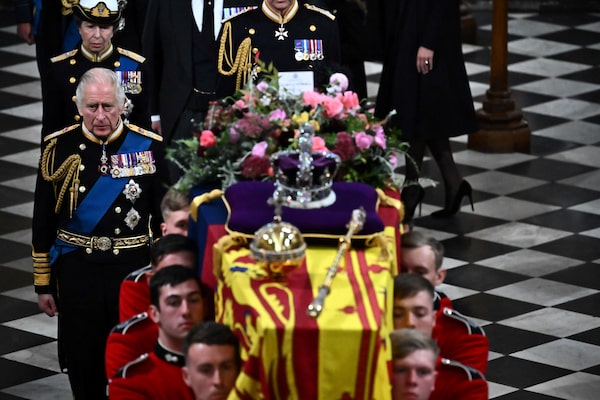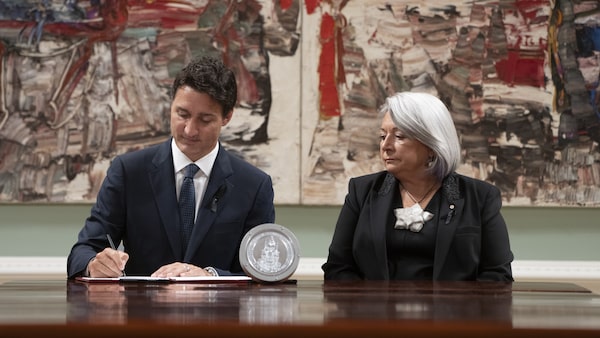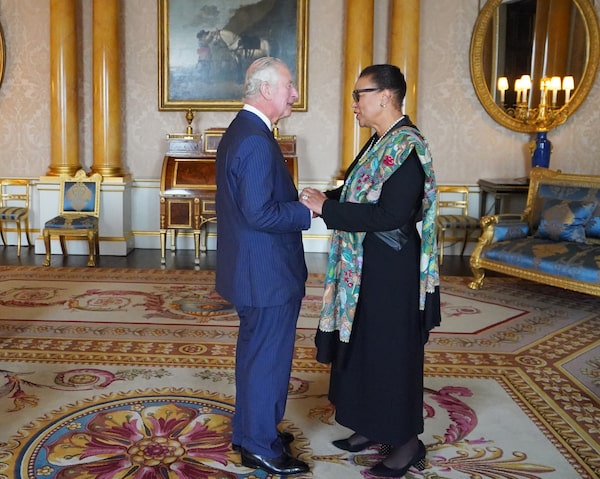
London, Sept. 19: King Charles III walks behind the coffin of his mother, Queen Elizabeth, at it leaves the state funeral at Westminster Abbey.Ben Stansall - WPA Pool/Getty Images
Canadians are getting used to calling King Charles III, a man most have known as a prince for all their lives, as the new head of state – and so are Britons, New Zealanders and others in Commonwealth realms around the world.
The changes will be subtle and symbolic at first: Over the next few years, His Majesty’s name and image will replace his mother’s on currency, official documents and the names of public institutions. But if Caribbean monarchies go ahead with referendums on changing into republics, the debate about whether Canada should do likewise will reopen thorny constitutional questions. Here’s a primer.
The new King’s first days

The King makes a televised speech from the Blue Drawing Room at Buckingham Palace in London on Sept. 9, the day after his mother's death.YUI MOK/POOL/AFP via Getty Images
Charles, 73, was heir-apparent for more than six decades, the longest wait of any prince for the British throne – meaning Canada and other Commonwealth realms had plenty of time to prepare. In Britain, the death of his mother, Queen Elizabeth, on Sept. 8 triggered a long-gestating succession plan called Operation Spring Tide, which ran concurrently with the official mourning of his mother (called Operation Unicorn in its Scottish phase, and Operation London Bridge for overall activities nationwide). That included:
- Sept. 9: A recorded speech by the King was broadcast worldwide, in which he promised to “uphold the constitutional principles at the heart of our nation” as his mother had.
- Sept. 10: Members of Britain’s Accession Council, a ceremonial body, affirmed that the King is their new king. Canada’s Parliament did the same, as have New Zealand, Australia and other countries where the monarch is head of state.
- Sept. 12-16: The King toured the U.K., Scottish, Northern Irish and Welsh legislatures to get their official condolences.
- Sept. 13-19: When Queen Elizabeth’s coffin arrived in London, the King and other Royal Family members took part in the procession to Westminster Hall and the days of lying-in-state when the public could visit. The Queen’s funeral began on Sept. 19, with a committal and private funeral to follow at Windsor Castle.
The King will eventually have a coronation, a mission known in official British circles as Operation Golden Orb, but the date and details will take time to arrange. The rites are a formality, so there’s no rush; his mother wasn’t crowned until 16 months after her father died in 1952.
Which Royal Family members have changed titles?

Prince Charles marks his 70th birthday at Clarence House in 2018 with his wife, children and grandchildren.Chris Jackson/Pool photo
Charles
- Before: Charles, Prince of Wales, addressed as “His Royal Highness,” the title that Royal Family members other than the monarch use.
- Now: King Charles III, addressed as “His Majesty.” Had he wanted a different regnal name, he could have used any part of his full name, Charles Philip Arthur George; monarchs sometimes do this to create continuity with their predecessors, or set themselves apart from them.
Camilla
- Before: Camilla, Duchess of Cornwall.
- Now: Camilla, Queen Consort. When she and Charles married in 2005, there was an agreement she would not get a “queen” designation when Charles became king, but Elizabeth eventually gave her blessing for it.
William and Catherine
- Before: Duke and Duchess of Cambridge.
- Now: Prince and Princess of Wales, and Duke and Duchess of Cornwall and Cambridge. Their children George, Charlotte and Louis now advance one step up in the line of succession.

The Royal Family
Lines of succession
Line of firstborn heir
Remaining line
Deceased
King George VI
1895 – 1952
Reign 1936 – 1952
Queen Elizabeth II
1926 – 2022
Reign 1952 – 2022
Princess Margaret
Countess of Snowdon
1930 – 2002
King Charles
Born 1948
Reign 2022 –
Prince William
Duke of Cambridge
1982
1
2
Prince George
2013
3
Princess
Charlotte*
2015
4
Prince Louis
2018
Prince Harry
Duke of Sussex
1984
5
6
Archie
2019
7
16
Lilibet
2021
Princess Anne
Princess Royal
1950
Peter
Phillips
1977
17
18
Savannah
2010
19
Isla
2012
Zara
Tindall
1981
20
8
21
Mia
2014
Prince Andrew
Duke of York
1960
22
Lena 2018
23
Lucas
2021
Princess
Beatrice
1988
9
10
Sienna 2021
Princess
Eugenie
1990
11
12
13
August
2021
Prince Edward
Earl of Wessex
1964
James,
Viscount Severn
2007
14
Lady
Louise
2003
15
*The rule of succession was changed in 2013 to include daughters as well as sons. Previously, daughters could only inherit the British throne if there were no living sons.
SOURCE: REUTERS

The Royal Family
Lines of succession
Line of firstborn heir
Remaining line
Deceased
King George VI
1895 – 1952
Reign 1936 – 1952
Queen Elizabeth II
1926 – 2022
Reign 1952 – 2022
Princess Margaret
Countess of Snowdon
1930 – 2002
King Charles
Born 1948
Reign 2022 –
Prince William
Duke of Cambridge
1982
1
2
Prince George
2013
3
Princess
Charlotte*
2015
4
Prince Louis
2018
Prince Harry
Duke of Sussex
1984
5
6
Archie
2019
7
16
Lilibet
2021
Princess Anne
Princess Royal
1950
Peter
Phillips
1977
17
18
Savannah
2010
19
Isla
2012
Zara
Tindall
1981
20
8
21
Mia
2014
Prince Andrew
Duke of York
1960
22
Lena 2018
23
Lucas
2021
Princess
Beatrice
1988
9
10
Sienna 2021
Princess
Eugenie
1990
11
12
13
August
2021
Prince Edward
Earl of Wessex
1964
James,
Viscount Severn
2007
14
Lady
Louise
2003
15
*The rule of succession was changed in 2013 to include daughters as well as sons. Previously, daughters could only inherit the British throne if there were no living sons.
SOURCE: REUTERS

The Royal Family
Lines of succession
Line of firstborn heir
Remaining line
Deceased
King George VI
1895 – 1952
Reign 1936 – 1952
Queen Elizabeth II
1926 – 2022
Reign 1952 – 2022
Princess Margaret
Countess of Snowdon
1930 – 2002
King Charles
Born 1948
Reign 2022 –
Prince William
Duke of Cambridge
1982
1
16
Princess Anne
Princess Royal
1950
Prince George
2013
2
Princess
Charlotte*
2015
Peter
Phillips
1977
3
17
Prince Louis
2018
4
18
Prince Harry
Duke of Sussex
1984
Savannah
2010
5
19
Archie
2019
6
Isla
2012
Lilibet
2021
7
Zara
Tindall
1981
20
Mia
2014
21
8
Lena
2018
22
Prince Andrew
Duke of York
1960
Lucas
2021
23
Princess
Beatrice
1988
9
Sienna 2021
10
Princess
Eugenie
1990
11
August
2021
13
12
Prince Edward
Earl of Wessex
1964
James,
Viscount Severn
2007
14
*The rule of succession was changed in 2013 to include daughters as well as sons. Previously, daughters could only inherit the British throne if there were no living sons.
Lady
Louise
2003
15
SOURCE: REUTERS
Charles’s past: A primer
For decades, Charles’s public approval in Britain and elsewhere has been much lower than that of his mother, and republicans have argued that his succession should be the last straw before a break with the monarchy. Here are some of the reasons his path to the throne has been so controversial.
London newspapers from Dec. 21, 1995, report on the Queen writing letters to Prince Charles and Princess Diana suggesting that they go ahead with an early divorce.Martin Cleaver/The Associated Press
- Marriage: Charles and Camilla’s long courtship began in the 1970s and didn’t end after her marriage to Andrew Parker Bowles in 1973 and his marriage to Diana, Princess of Wales, in 1981. The royal couple’s acrimonious divorce and Diana’s death in a car crash in Paris challenged the monarchy’s reputation in the 1990s and left deep rifts in the family for years to come.
- Children: The Sussexes’ 2021 interview with Oprah Winfrey raised uncomfortable questions for Charles and his family as Harry described how his father stopped accepting his calls. “My father and my brother, they are trapped” in their royal roles, Harry said. Meghan, who is mixed-race, alleged racist remarks by an unnamed member of the family and a general lack of care for her suicidal thoughts. Those allegations prompted an internal review of Buckingham Palace’s diversity policies.
- Political views: Constitutional monarchs are expected to be impartial and keep contentious opinions to themselves. In the 2000s, Charles’s ability to do that came into question when British journalists learned he had written strongly worded private letters to government ministers – later dubbed the “black spider memos” for his disordered handwriting – pressing Tony Blair’s Labour government on issues from agriculture to the war in Iraq.
How the succession works in Canada and the Commonwealth

Governor-General Mary Simon looks on as Prime Minister Justin Trudeau signs documents during an accession ceremony at Rideau Hall on Sept. 10.Adrian Wyld/The Canadian Press
Who is Canada’s head of state? Who is its head of government?
Most countries have a head of state (a leader who symbolizes the nation and the people’s sovereignty over it) who’s different from the head of government (the person in charge of the elected legislature that decides public policy and spending). In Canada, the prime minister is head of government and the monarch is head of state.
Governors-general, who represent the monarchy in Canada, sometimes call themselves de facto heads of state because they do the routine ceremonial tasks like Throne Speeches, calling elections and playing host to state functions. In extreme circumstances where Parliament’s authority has completely broken down, governors-general can restore order with the monarch’s reserve powers, such as dismissing a prime minister who lacks support from the House. But the governor-general does these things in the name of the sovereign, who is now Charles.

The King meets Commonwealth Secretary-General Baroness Patricia Scotland at Buckingham Palace on Sept. 11.Victoria Jones-WPA Pool/Getty Images
How many sovereigns does the Commonwealth have?
The concept of “the queen is dead, long live the king” involves an important double meaning: The sovereign as a private, or natural, person, and as a legal person. As natural people, monarchs are individuals who can die, but the legal person – the state they represent – is singular and unkillable. It’s what legal scholars call a corporation sole that automatically flows from one natural person to another.
Constitutionally speaking, a monarch is dozens of legal persons all at once, one for each realm and, in the federations of Canada and Australia, their provinces or states. Within a country, Crowns are split among different branches of government: The executive (called the King-in-Council in Canada), legislature (King-in-Parliament) and courts (King’s Bench).
Charles now inhabits all these roles, but when each country’s laws and official documents say “the Crown” or “His/Her Majesty,” they’re really talking about the independent governments that the sovereign now embodies: The legal person, not the natural one.
Countries where Charles is now king

1
2
3
4
5
6
7
8
12
11
9
10
13
14
15
Belize
1
United Kingdom
9
10
Jamaica
2
Canada
3
Papua New Guinea
11
St. Kitts and Nevis
Solomon Islands
Antigua and
Barbuda
4
12
5
Tuvalu
St. Lucia
13
6
Australia
14
St. Vincent and
the Grenadines
7
New Zealand
8
The Bahamas
15
Grenada
MURAT YÜKSELIR / THE GLOBE AND MAIL, SOURCE:
COMMONWEALTH SECRETARIAT; COUNCIL ON
FOREIGN RELATIONS

1
2
3
4
5
6
7
8
12
11
9
10
13
14
15
Belize
1
United Kingdom
9
10
Jamaica
2
Canada
3
Papua New Guinea
11
St. Kitts and Nevis
Solomon Islands
Antigua and
Barbuda
4
12
5
Tuvalu
St. Lucia
13
6
Australia
14
St. Vincent and
the Grenadines
7
New Zealand
8
The Bahamas
15
Grenada
MURAT YÜKSELIR / THE GLOBE AND MAIL, SOURCE:
COMMONWEALTH SECRETARIAT; COUNCIL ON FOREIGN
RELATIONS

1
2
3
4
5
6
7
8
1
6
Australia
11
St. Kitts and Nevis
United Kingdom
Antigua and
Barbuda
12
Canada
New Zealand
2
7
11
12
3
Papua New Guinea
8
The Bahamas
13
St. Lucia
9
10
13
14
St. Vincent and
the Grenadines
Solomon Islands
Belize
4
9
14
5
Tuvalu
10
Jamaica
15
Grenada
15
MURAT YÜKSELIR / THE GLOBE AND MAIL, SOURCE: COMMONWEALTH SECRETARIAT; COUNCIL ON FOREIGN RELATIONS
Does this mean I need to change my Canadian passport?
Eventually, but the one you have will still work: The government may have issued it to you in Elizabeth’s name, but it meant the legal person of the Crown, not the individual. Passports are only one of the many official documents, from court records to government contracts, where the Queen’s name will be phased out and the King’s phased in, a process that could take years.
What happens to Canadian money with the Queen’s image on it?
The Royal Canadian Mint has used Elizabeth’s image on $20 bills and coins since the 1950s, and you can expect to keep seeing it in your transactions for years to come.
First, the mint has to finalize new designs with Charles’s likeness, then manufacture the money; gradually, financial institutions will remove old currency from circulation when it is too damaged to use, but the process will be largely invisible to the average Canadian.
Barbados' new President Sandra Mason awards Charles with the Order of Freedom of Barbados on Nov. 30, 2021.Toby Melville/Reuters
If I don’t want Charles to be king, what can I do?
If you feel that now is the time for a Barbadian-style shift toward a republic in Canada, you likely aren’t alone, but it’s not going to be that easy or as fast.
In 2021, Barbados, one of Britain’s former Caribbean colonies, made its head of state a president chosen by Parliament (which, as in Canada, consists of elected MPs in one chamber and appointed senators in another). The governing party controlled all but one House seat and most Senate seats, more than enough for the two-thirds-majority votes it needed – and since Barbados isn’t a federal state, their decision was the only one that counted. But to change the royal-related parts of Canada’s Constitution, the federal and all 10 provincial legislatures would have to agree. They’d also have to consult Indigenous nations whose political status is protected by treaties and royal proclamations that, over the centuries, were all signed in the sovereign’s name.
Canada’s past attempts at Constitution change on that scale didn’t end well. The 1987 Meech Lake Accord, which proposed new provincial powers and “distinct society” status for Quebec, fell apart in the ratification stages; its 1992 follow-up, the Charlottetown Accord, added provisions for Indigenous self-government and an elected Senate, but Canadians rejected it in a national referendum. Those defeats angered Quebec separatists and led to 1995′s referendum, which the No side only narrowly won. Ever since, political leaders have been cautious about reopening the Constitution, and mixed public support for the monarchist and republican sides has not encouraged them to change their minds.
Royal succession: More from The Globe and Mail
The Decibel
Vicky Mochama, a Globe contributor who writes about the Royal Family, looks back at the Queen’s achievements and what the monarchy’s future might be without her. Subscribe for more episodes.
His Majesty’s future
Philippe Lagassé: Legally speaking, Charles is now the King of Canada
Her Majesty’s legacy
Obituary: Queen Elizabeth, the monarch of modernity
In visits to Canada, Elizabeth left her mark as British history’s most travelled monarch
Editorial: She was from another age. That’s why she was so good at her job
Compiled by Globe staff
With reports from Paul Waldie and The Canadian Press